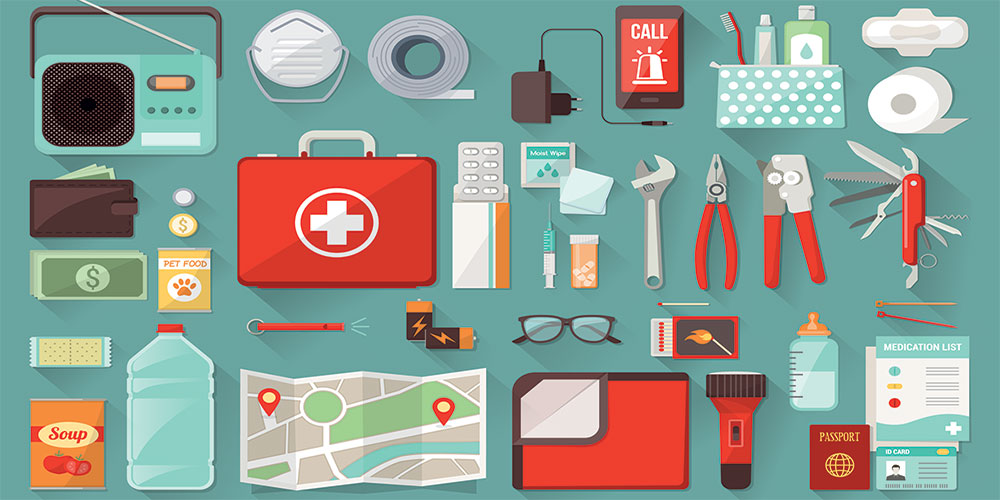UPDATE: 10/15/24
With two major hurricanes hitting the United States in just two weeks, we are reposting this article. If you live in an area prone to hurricanes, do you have a go-bag at the ready?
UPDATE: 9/28/22
As Hurricane Ian makes landfall in Florida as a Category 4 storm, we wanted to repost this article to remind people of the importance of having a hurricane kit ready for when/if a storm hits your area. Stay safe and we’re thinking of everyone in Florida and the residents of Cuba as they work to recover.
ORIGINAL POST: 8/30/2019
With hurricane season in full swing and Central and South Florida brace for the impact of Hurricane Dorian next week, we wanted to provide you with the Federal Emergency Management Agency (FEMA)’s list of recommended items to have in a hurricane emergency kit.
Through its Ready Campaign, FEMA educates and encourages Americans to take some simple steps to prepare for and respond to potential emergencies, including natural disasters and terrorist attacks.
Here are some basic items your hurricane kit (or any emergency kit, really) should include:
- One gallon of water per person per day for at least three days for drinking and sanitation
- At least a three-day supply of non-perishable food
- Battery-powered or hand crank radio and a National Oceanic and Atmospheric Administration (NOAA) Weather Radio with tone alert
- Flashlight
- First aid kit
- Extra batteries
- Whistle to signal for help
- Dust mask
- Moist towelettes
- Garbage bags
- Plastic ties for personal sanitation
- Wrench or pliers to turn of utilities
- Manual can opener for food
- Local maps
- Cell phone with chargers and a backup battery
It would also be beneficial to sign up to receive alerts from your state and local emergency notification systems.
Storing Your Hurricane Emergency Kit Items
FEMA recommends storing these items in airtight plastic bags and keeping the entire kit in one or two easy-to-carry containers, such as plastic bins or duffel bags. Be sure to keep canned foods in a cool, dry place.
Since you do not know where you will be when an emergency occurs, FEMA says, prepare supplies for home, work and vehicles.
- Home: Keep this kit in a designated place and have it ready in case you have to leave your home quickly. Make sure all family members know where the kit is kept.
- Work: Be prepared to shelter at work for at least 24 hours. Your work kit should include food, water and other necessities like medicines, as well as comfortable walking shoes, stored in a “grab and go” case.
- Vehicle: In case you are stranded, keep a kit of emergency supplies in your car. In addition to the recommended items above, your car should also include jumper cables, flares, an ice scraper, a cell phone charger, a blanket, a map and cat litter or sand for tire traction.
Additional Items You May Need
FEMA also recommends you consider the unique needs your family might have, including supplies for pets or seniors. Be sure to reevaluate your family’s needs every year and update your kit. These items may include:
- Prescription medications
- Non-prescription medications such as pain relievers, anti-diarrhea medication, antacids or laxatives
- Glasses and contact lens solution
- Infant formula, bottles, diapers, wipes, diaper rash cream
- Pet food and extra water for your pet
- Cash or traveler’s checks
- Important family documents such as copies of insurance policies, identification and bank account records saved electronically or in a waterproof, portable container
- Sleeping bag or warm blanket for each person
- Complete change of clothing appropriate for your climate and sturdy shoes
- Household chlorine bleach and medicine dropper to disinfect water
- Fire extinguisher
- Matches in a waterproof container
- Feminine supplies and personal hygiene items
- Mess kits, paper cups, plates, paper towels and plastic utensils
- Paper and pencil
- Books, games, puzzles or other activities for children
Additionally, ready.gov provides recommended actions before, during and after a hurricane to keep you and your loved ones safe. You can check those out here.













